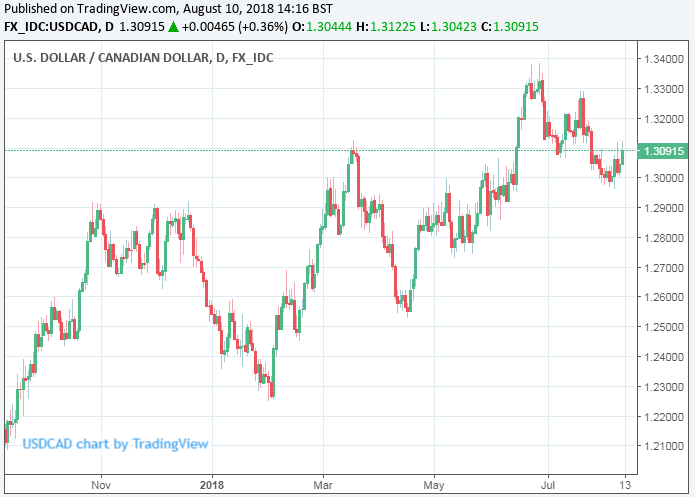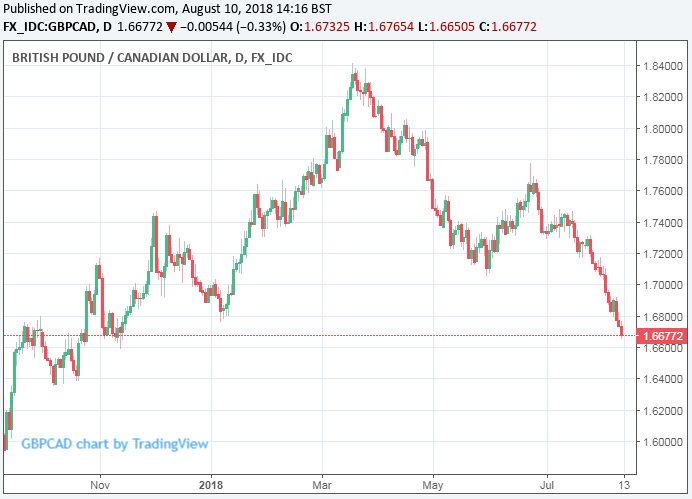Canadian Dollar Advances after Jobs Growth Beats by Country Mile and as Markets Eye BoC
- Written by: James Skinner
-
-Jobs growth of 54k bests consensus and unemployment falls.
-But the gains were part-time and in the public sector, not private.
-Data leaves market eyeing September or October for BoC rate rise.

© Pavel Ignatov, Adobe Stock
The Canadian Dollar rose broadly Friday after official data showed the economy creating new jobs at a rapid clip during July, raising the odds of another Bank of Canada interest rate rise being delivered before the year is out.
Canada's economy created 54,100 new jobs during July, up from a 31,800 gain in June, which was a country mile ahead of the consensus for jobs growth of just 17,000. This was enough to push the unemployment rate back down to 5.8%, its joint lowest in the current economic cycle, from 6% back in June.
However, and on the downside, the jobs gains were driven by an increase in public sector employment and not the private sector. Statistics Canada says most of the employment gains were in Ontario, British Columbia, Newfoundland and Labrador while the number of workers declined in Saskatchewan and Manitoba.
"In the wacky world of Canada's monthly employment numbers, July came up with another head scratcher, with some big headlines but some disappointments in the fine print," says Avery Shenfeld, chief economist at Toronto-headquartered CIBC Capital Markets. "July gains were all part time, with full time work down 28K. Nearly all of the job gain was in the public sector."
Markets care about the labour market data because falling unemployment and improving job creation, according to conventional thinking on the subject, put upward pressure on wages. Wage growth itself leads to increased demand within an economy and exerts upward pressure on inflation, which has implications for interest rates and financial markets.
Changes in interest rates, or hints of them being in the cards, are only made in response to movements in inflation but impact currencies because of the push and pull influence they have on international capital flows and their allure for short-term speculators.
"Overall, still a "good" set of numbers that will keep markets guessing between a September and October (our pick) hike by the Bank of Canada, but there are lots of reasons to question just how good the data really are here," Shenfeld adds.

Above: USD/CAD rate shown at daily intervals.
The USD/CAD rate was quoted 0.16% higher at 1.3068 following the release after paring back a 0.50% gain, while the Pound-to-Canadian-Dollar rate was 0.28% lower at 1.6688. The Canadian Dollar was quoted higher against most other developed world currencies Friday.
"Given that positioning still looks a bit short and HFFV looks clean, we think a positive surprise and some repricing of the BoC later this year warrants a deeper correction in the [USDCAD] pair," says Mark McCormick, North American head of FX strategy at Toronto-headquartered TD Securities. "Again, we suspect this setup is widely a positioning squeeze — not a reversal — and will offer more attractive levels to buy down the road. For CAD bulls, we prefer to remain short AUDCAD in cash."

Above: Pound-to-Canadian-Dollar rate shown at daily intervals.
Sentiment toward the Canadian currency has improved in recent weeks, particularly after official data showed economic growth surging in May and exports rising at a rapid clip during June, placing the economy on track to deliver a solid performance for the second-quarter.
Canada's trade deficit shrank to just -$626 million during June which, down from -$2.7 billion in May, after exports surged by 4.1% to a record $50.7 bn. Canadian GDP rose by 0.5% in May, up from 0.1% previously, placing the economy on track to achieve annualised growth of around 3% for the second quarter.
The recent improvement in economic data is significant for currency markets because it is seen making a third 2018 interest rate rise from the Bank of Canada (BoC) more likely, when just a few short weeks ago, analysts and economists were sceptical about whether the BoC would manage another hike this side of the New Year.
The Bank of Canada raised its interest rate for the fourth time in the last 12 months this July, taking it up to 1.5%, and signalled its intention to continue withdrawing stimulus from the Canadian economy over the coming quarters.
Pricing in overnight index swaps markets, which enable investors to protect themselves against changes in rates but also provide insight into expectations for monetary policy, implied an October 24, 2018 cash rate of 1.70% Friday. This suggests markets are confident another rate rise will come before the year is out.
This helped partially reverse the tide of increasingly negative sentiment, stemming from uncertainty over the future of the North American Free Trade Agreement (NAFTA), that had driven the Loonie to year-lows back in June and July. However, the ongoing prospect of failure to agree a deal remains a significant risk to the Loonie.
Canadian foreign minister Chrystia Freeland was excluded from the latest round of NAFTA talks as US officials sought to make headway in the negotiations with just their newly-minted Mexican counterparts. This raises the spectre of Canada being sidelined from any new deal with Mexico, which would mean it has little choice but to seek a bilateral deal with the US.
The renegotiation was organised after President Donald Trump criticised the NAFTA pact, which facilitates tariff-free trade between its signatories, and threatened to withdraw from it unless more terms more palatable to the US administration can be agreed.
"Canada’s foreign affairs minister may be upbeat on recent NAFTA trade talks, but there are growing risks that an agreement just between the US and Mexico could leave Canada out in the cold," says James Knightley, chief international economist at ING Group. "Our FX team believes that the risks from any negative talk on a trilateral Nafta agreement will keep USD/CAD above 1.30 – and we’d need to see positive NAFTA news, or a surge in the stability of the US trading environment, in order to see a USD/CAD move below 1.30."
TD Securities analysts previously estimated a US withdrawal from NAFTA could see the Canadian Dollar fall by 20% as markets would be forced to mark down their expectations for Canadian economic growth and interest rates over the longer term. The USD/CAD rate is already 4% lower thus far in 2018.
Advertisement
Get up to 5% more foreign exchange by using a specialist provider to get closer to the real market rate and avoid the gaping spreads charged by your bank when providing currency. Learn more here





